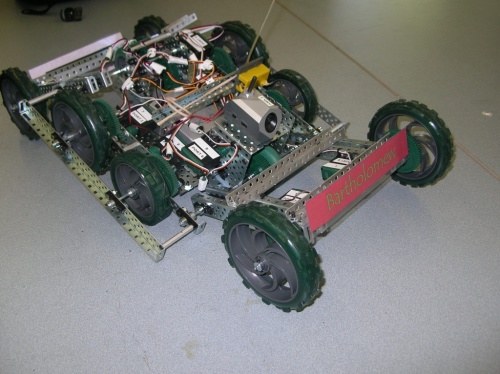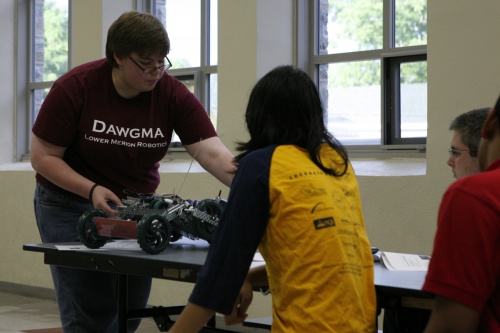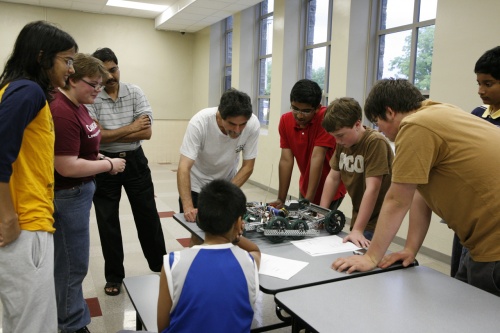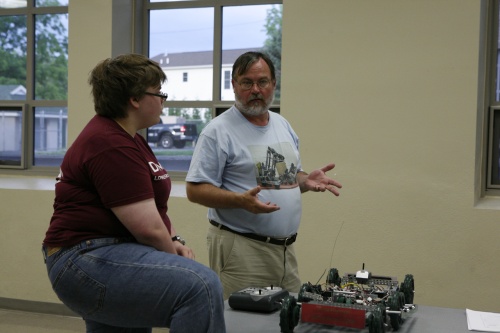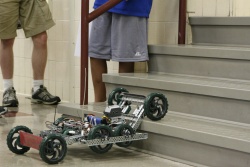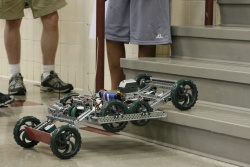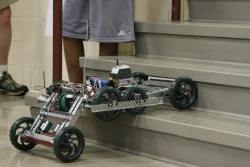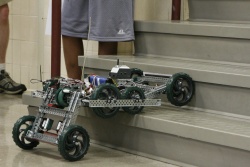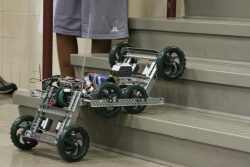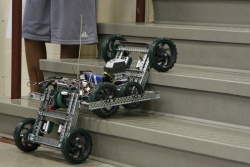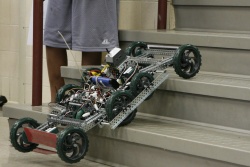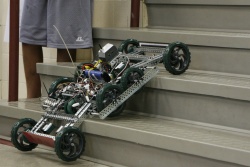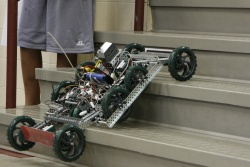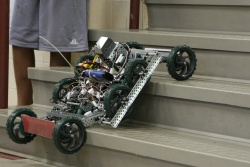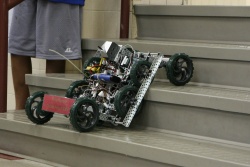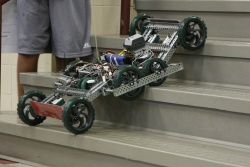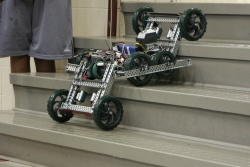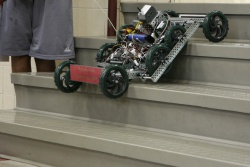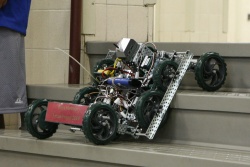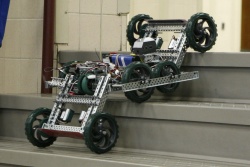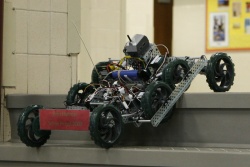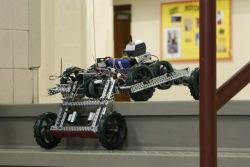Bartholomew
From DEW Robotics
Revision as of 02:38, 25 February 2010 by MaiKangWei (talk | contribs)
Petra Hartman built a stair climbing VEX bot named Bartholomew for her senior project at Lower Marion High School. She came to Downingtown Area Robotics on June 24 to demonstrate Bartholomew.
The information below came from her presentation. When she was done with her talk she demonstrated Bartholomew climbing the short steps in the cafeteria. There are pictures below and a video of another climb.
Contents
- 1 Background
- 2 Research
- 3 Tank Tread Design
- 4 Bartholomew Facts
- 5 Why Build Bart?
- 6 Current Bart
- 7 Largest Problems
- 8 What Stairs to Use?
- 9 Back Drive in the Gearbox
- 10 Problems With Back Lifting Mechanism
- 11 Supporting Structure
- 12 What skills did I learn
- 13 Future Iterations
- 14 What will happen to Bart?
- 15 Photo Gallery - Bartholomew Stair Climbing Sequence
Background
- Senior project - required by the school as a graduation requirement
- Three weeks off school to do it
- Can do any kind of project, but needs a sponsor sign off
- Must work a minimum of 100 hours
- 3 Objectives
- Climb Stairs (accomplished)
- Autonomous climb up stairs
- Find the max speed/gear ratio (accomplished)
Research
- Did research via the web and looking at YouTube clips
- 3 main designs
- Treads -- classic long treads that grab the front of the stairs and pull the robot up
- Treads with lifting mechanisms -- tread support on a step, then lift up and over to the next step
- "Flipping" axle wheel -- wheels follow same pattern as up and over treads
Tank Tread Design
- Makes the robot much larger than it should be
- Long tread design to cover a number of stair fronts
- Treads offer very little friction
- Tried new tread upgrades
- Tried different materials to add friction
- Main reasons for not continuing with treads:
- Boggie wheels would loosen, tread would flop around
- Treads would hit and get stuck in corners of the stairs
- Stair configuration (rise:tread ratio) changing
Bartholomew Facts
- Able to climb stairs up to 7" rise, 12.75" deep
- Version 4.4 (19th integration in total)
- Uses 10 motors
- Each wheel driven (5:1 gear ratio)
- Gearbox for "lift" parts has a 10:1 ratio.
- Starting position 28.75" * 13"
Why Build Bart?
- To graduate
- How can Bart be used?
- Bomb Disposal
- Climbing Wheelchair
- Mars Rover - design to allow stepping over bigger rocks
Current Bart
- Bad:
- Shaft Collars - with all the shafts there are a LOT of collars in use. Some of them are hard to get to.
- Controls - drive controls are a little tricky, sticks are arcade mode for front and rear. Back buttons are for pivots.
- Good:
- Repeatable Behavior
- Works or several rise:tread combinations
- Easy to Shape
Largest Problems
- Stairs - started out using custom built, portable stairs. But has Bart grew is size, switched over standard stairs
- Gearbox - speed and lift design
- Back Lifting Mechanism - lots of design details to work out
- Support - Bart got heavy, frame needs to be strong, pivots on shafts is a problem
- Tread depths
What Stairs to Use?
- First version = Nightmare
- Rise:tread ratio 4"x4"
- Had a large lip
- Open back (like outdoor stairs)
- 10 iterations in:
- Using the school's stairs
- Still have to deal with a front lip
- Testing on multiple stairs
Back Drive in the Gearbox
- Gearbox started at 5:1 ratio
- Asked John V-Neun for help
- Worm gears
- Surgical Tubing
- Higher Reduction
- 10:1 ratio
- Use the thick gears and 12 pitch metal for strength
Problems With Back Lifting Mechanism
- Back section was sinking in on itself after 90 degrees
- Mechanical stop was installed
- Solid metal parts used
- Good, but eventually bends
- Limit Switch:
- Used VEX push button
- Placed on back support beam
- Tells robot to stop moving gearbox clockwise
- Avoids back sinking in
Supporting Structure
- All of the mass is in the center of the robot
- Causes a lot of bending and twisting force on the shaft between the wheels
- Placed additional support rails
- Reduced the amount of force causing the shaft to bend.
- Slowly adding on to the mechanism for strength
- Center base would bend outwards when it hit the step
- Symmetry to help balance the robot while on the stairs
What skills did I learn
- Higher importance:
- Design Notebook - keeping track of where I was in the design process. Kept from repeating discarded ideas.
- Iterative process - constant refinement of ideas
- Problem solving - each step of iteration uncovered new problems to be resolved
- Learning how to make a PowerPoint for presentations
- If people start coming up with crazy ideas, its coming along ...
- Smaller Things:
- Use of Y cables
- Importance of filing sharp edges. A few seconds with a file saved many scrapes later on. Tight spaces means lots of hand / metal contact.
- Managing and Labeling of Electronics - important to keep track of the mass of wires and connections.
Future Iterations
- Add More Sensors
- Full Autonomous
- Able to climb any rise:tread combination
- Two Cameras - one faces forward, add second rear facing camera.
What will happen to Bart?
- Demos
- Future work on Full Autonomous programming
- Deconstructed for Parts
- Largest VEX robot built at the school
- Estimate is around $1000 in parts were used
